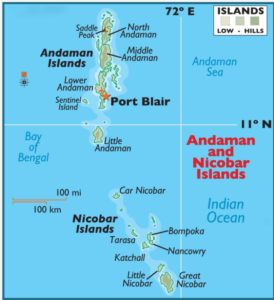26 June 2024 : Indian Express Editorial Analysis
1. Security and ecology
(Source: Indian Express; Section: The Editorial Page; Page: 10)
| Topic: GS3 – Environment – Environment Pollution and Degradation GS3 – Internal Security |
| Context: |
|
Historical Insight:
- As far back as 1945, India’s visionary historian-diplomat Sardar K. M. Panikkar had warned about the strategic importance of the Andaman & Nicobar (A&N) archipelago for controlling the Bay of Bengal.
- He emphasized that the active control of the Indian Ocean and the defense of the coastline were only possible by using islands as advanced bases.
- However, India’s focus on the western Indian Ocean, due to perennial issues with Pakistan and ties with the Persian Gulf, led to a neglect of its eastern waters, including the A&N archipelago.
Strategic Neglect and Shift:
- Despite the strategic warnings, India’s eastern waters, including the A&N islands, remained neglected.
- The region’s maritime remoteness and historical complexities, including Britain’s post-independence considerations and Indonesia’s offer to annex the islands during the 1965 conflict on behalf of Pakistan, contributed to this oversight.
- The islands’ significant distance from mainland India further compounded this neglect. However, the strong economic opportunities in Southeast Asia and the ASEAN region eventually led to the implementation of the Look East and Act East policies, signaling a shift in focus.
Strategic and Economic Vision:
- Any long-term vision for the A&N islands must prioritize two major components: defense and economic development.
- The islands are crucial for India’s national security, serving as a strategic maritime bastion and sentinel of the Malacca Straits. Equally important is their economic development, aimed at making the islands self-sustaining and prosperous for the inhabitants.
- Panikkar’s advice was heeded post-Kargil when the joint/tri-service A&N Command (ANC) was established in Port Blair in 2001.
- Despite initial neglect, recent efforts are underway to fortify the ANC, with plans to enhance the navy and air force bases across the islands.
Resource Potential and Indigenous Preservation:
- The A&N islands possess rich maritime resources, including a significant Exclusive Economic Zone (EEZ) that constitutes 30% of India’s total EEZ.
- The waters abound in marine life and potential hydrocarbon reserves. More importantly, the islands are home to indigenous tribes such as the Onge, Jarawa, Sentinelese, and Shompens, whose protection is paramount.
- Given the limited scope for industrial and agricultural activity, tourism and fisheries have been considered sustainable avenues for development and employment.
Controversial Development Projects:
- Recently, a plan for the “Holistic Development of Great Nicobar Island” (GNI) was conceived by the NITI Aayog, encompassing a Rs 75,000 crore mega-infrastructure project.
- This includes an international container transshipment terminal, an international airport, power plants, greenfield cities, and a coastal mass rapid transport system.
- Despite environmental clearances, the project has faced protests from conservationists and civil society groups due to potential environmental and anthropological impacts, particularly on the Shompen tribe and the unique flora and fauna of the UNESCO Biosphere Reserve in GNI.
Critical Considerations and Alternatives:
Several issues warrant reconsideration in light of ongoing protests.
- First, the security capabilities of ANC should be addressed independently of the GNI development plans.
- Second, the viability of another transshipment terminal in GNI is questionable, given its distance from established hubs and the recent commissioning of a terminal in Vizhinjam, Kerala.
- Third, the idea of replicating duty-free ports on GNI, far from mainland resources and industrial backup, seems unrealistic.
- Lastly, other islands in the Nicobar group, such as Little Nicobar, Nancowry, Kamorta, and Katchall, could accommodate project components without causing extensive environmental damage, drawing lessons from Chinese engineering feats in the South China Sea.
| About Great Nicobar Island |
|
|
PYQ: Which one of the following pairs of islands is separated from each other by the ‘Ten Degree Channel’? (2014) (a) Andaman and Nicobar (b) Nicobar and Sumatra (c) Maldives and Lakshadweep (d) Sumatra and Java Ans: (a) |
| Practice Question: Discuss the strategic importance of the Andaman & Nicobar Islands for India and critically analyze the recent mega-infrastructure development project proposed for Great Nicobar Island, considering its potential environmental and socio-cultural impacts. (250 words/15 m) |
2. A strategic window
(Source: Indian Express; Section: The Ideas Page; Page: 11)
| Topic: GS2 – International Relations |
| Context: |
|
Asia’s Enhanced Role in Global Affairs:
- Asia is no longer a passive player in the global geopolitical arena. Historically, during the colonial era, Asian resources were vital in shaping the economic and geopolitical destinies of European imperial powers.
- Indian military contributions significantly bolstered Britain’s dominance in the Indian Ocean and supported the Western allies in both World Wars.
- Today, Asian states exercise greater agency in shaping global power dynamics.
- Both Russia and Western Europe are actively courting Asian nations to influence the narrative and outcomes of the ongoing conflict in Ukraine.
Strategic Realignments and Alliances:
- The current conflict has led to significant realignments and new alliances. North Korea has emerged as a crucial supplier of ammunition to Russia, while South Korea is providing arms to Ukraine.
- China’s support for Russia, though indirect, and Washington’s pressure on Japan to liberalize arms exports underscore the intricate web of alliances.
- Putin’s visit to Pyongyang and Hanoi highlights Russia’s efforts to rebuild ties with North Korea and strengthen its position in Asia.
- Similarly, Vietnam’s strategic balancing act between the US, China, and Russia illustrates the growing agency of Asian nations.
Western Dilemmas and Strategic Shifts:
- The increasing maneuverability of Asian states has intensified dilemmas in the West. The US, once dominant in both European and Asian theatres, now faces the challenge of addressing simultaneous threats from Russia and China.
- A significant faction within the US political establishment argues for focusing military power in Asia, considering China as the primary challenge. This debate is likely to be a focal point in the upcoming presidential debates.
- Both Biden and Trump agree on the need for Europe to take greater responsibility for its own defense, relieving some of America’s burdens and enabling a more balanced approach to the dual challenges posed by Russia and China.
Opportunities for Middle Powers:
- The evolving geopolitical landscape offers unprecedented opportunities for middle powers like India. The US is keen to build strong security partnerships with these nations to counterbalance China and Russia.
- The concept of “integrated deterrence” emphasizes the importance of enhancing the comprehensive national power of middle powers, including military capabilities.
- For India, this presents a strategic window to modernize its defense industrial base and expand arms production, aligning with its goal of achieving self-sufficiency and “strategic autonomy.”.
Conclusion:
- The interconnections between European and Asian security are deepening, presenting both challenges and opportunities.
- Middle powers like India have a crucial role to play in this evolving geopolitical scenario, with significant potential to influence global power dynamics through strategic partnerships and defense modernization.
| Practice Question: Examine the impact of the increasing interconnections between European and Asian security on the geopolitical strategies of middle powers like India. Discuss the strategic opportunities and challenges presented by this evolving development. (150 words/10 m) |

 Great Nicobar is the southernmost and largest of the Nicobar Islands, a sparsely inhabited 910-sq-km patch of mainly tropical rainforest in southeastern Bay of Bengal.
Great Nicobar is the southernmost and largest of the Nicobar Islands, a sparsely inhabited 910-sq-km patch of mainly tropical rainforest in southeastern Bay of Bengal.


